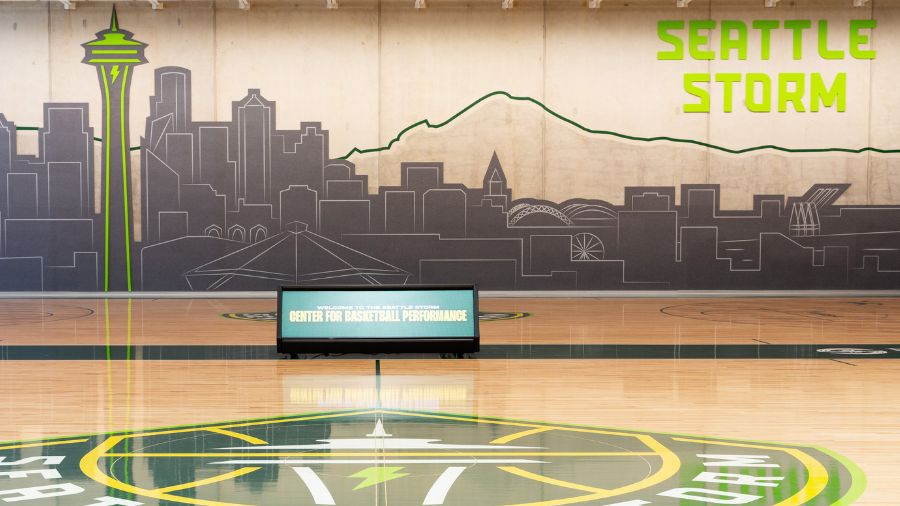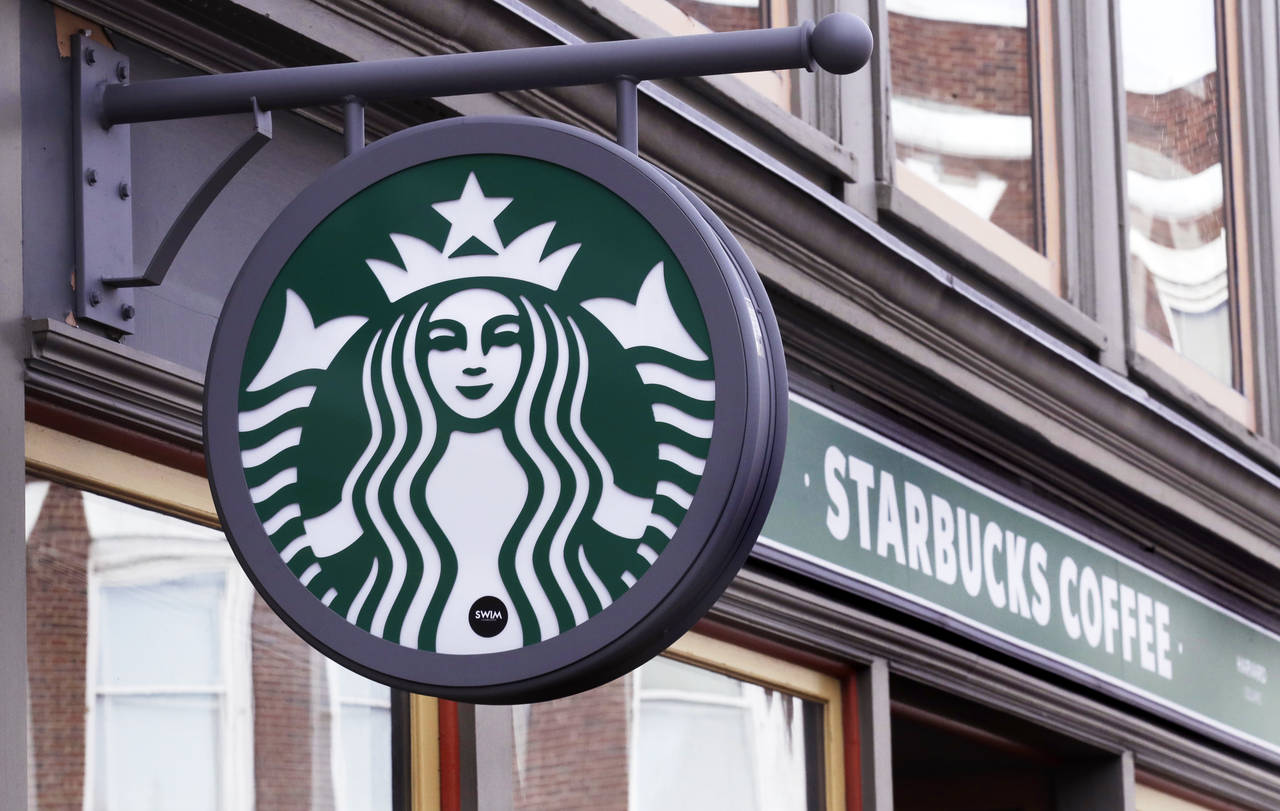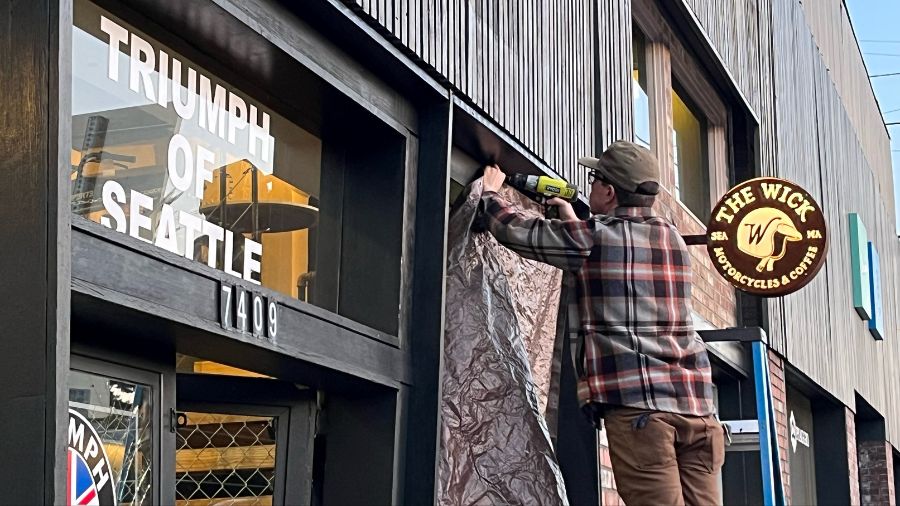Remembering Seattle’s ‘news out of the box’
Feb 15, 2017, 5:56 AM | Updated: Feb 5, 2024, 7:17 am

Steve Raible leads a tour of KIRO TV's "News out of the box" set during the premiere broadcast on February 4, 1993. Dave Ross is visible at the far right. (Courtesy Feliks Banel)
(Courtesy Feliks Banel)
In spite of all the ways to get news these days, fake or otherwise, local TV is a place where many people still turn to find out what’s going on.
Around here, KCPQ, KING, KIRO and KOMO all offer newscasts multiple times per day, via TV and the web. The newscasts all include well-groomed video newscasters, weathercasters, and sportscasters delivering stories from glitzy sets. Giant monitors play video, the telegenic journalists point to super-sized graphics, and cameras jump around the set to hear from reporters and other members of the news, traffic, weather and sports team.
Related: Northwest Cable News Signs Off After 21 Years
It wasn’t always this way. In the early 90s, most local TV newscasters sat behind desks, and only the weather guy (or gal) did much standing and pointing. And that was pretty much the case on all four local news channels until 24 years ago this month, when one station, all of a sudden, looked completely different.
At 5 p.m. on February 4, 1993, KIRO-TV, which was then owned by Bonneville (current owner of KIRO Radio), went live with a concept they called “news out of the box.”
As they bid farewell on live TV to the old news set in the KIRO studio at Third & Broad, anchors Steve Raible and Susan Hutchison took viewers on a guided tour around the future of television news.
“This set is done, as we know it, today,” Raible said, referring to KIRO’s traditional old TV new set, complete with standard anchor desk.
“And, if you come right this way, this is the beginning of our new set,” said Hutchison, with a videographer trailing her, as she walked toward a giant video screen (actually, in 1993 technology, this giant “screen” was made up of several smaller video monitors).
The giant screen was flanked by two men working at a desk. “This is called our ‘Command Center.’”
The sprawling studio/newsroom had multiple levels, with reporters and producers stationed on various platforms and ground level cubbies. The floor was decorated in black and white floor tile, while a Mount Rainier motif dominated the background, and a rotating collection of art borrowed from local museums graced the nooks and crannies. Theme music for the newscast was composed by then-Seattle Symphony conductor Gerard Schwarz.
“This is really what’s gonna be exciting about what we’re going to be doing, day-in and day-out, on KIRO News,” Raible continued, as he and Hutchison toured the set. “This is not something that we’re gonna do once or twice. This is where we work, every single day.”
Though Raible and Hutchison were enthusiastic in that inaugural broadcast, the viewing public never quite warmed to “news out of the box.” The experiment ended six months later. It was a ratings failure and, reportedly, a morale buster for staff. The news at KIRO-TV got put back inside the box, and in some circles, the whole thing came to be regarded as something of a joke.
Andy Ludlum was in charge of the move outside the box. He’d been the news director of what was then called KIRO Newsradio 710 (what’s now KIRO Radio 97.3 FM) when he was picked to oversee the transition. He’s retired now and lives in California.
Reached by phone, Andy Ludlum was skeptical about the value in revisiting this chapter of local TV history.
“[When I got your message] I kind of wondered, does anyone really care after all this time?” Ludlum said. “The program was only on for six months or so, so I always kind of suspected it was only the newspaper critics who needed to keep this whole thing alive in order to be able to say, ‘This is the worst thing to happen to Seattle since “news out of the box.”’”
For the record, “news out of the box” wasn’t Ludlum’s idea. The credit goes to Ken Hatch.
“The [then-] president of KIRO, Ken Hatch, told me that he thought the TV stations in the market . . . just all took turns being number one, two or three in the ratings, and he didn’t think there was a whole lot of difference between them,” Ludlum said.
“So he kinda wanted to shake up that paradigm or whatever by putting on a program that was completely different, and he said he was willing to take all the risks necessary to be innovative,” Ludlum said. “And I think his vision was that it would set KIRO apart from the competition.”
The effort certainly did set KIRO apart from the other TV stations in town, just not in the way Hatch had hoped.
“As I remember, the first broadcast had pretty good ratings because everybody wanted to tune in to see what happened,” Ludlum said. “It was only over the following days that we found out that there was something wrong, that the audience wasn’t staying as long we expected and hoped.”
“One of the things that we had the biggest problem with was we had the Assignment Desk up in the front of the set . . . and part of the idea, at least the vision that Ken [Hatch] had, was that this was going to be somewhat of a nerve center, or a ‘Command Center,’” Ludlum said, echoing the words Susan Hutchison had used in the premiere.
“Unfortunately, it just looked like people sitting behind a desk.”
The ratings continued to drop, Ludlum says, and, before too long, the days were numbered for “news out of the box.”
Ludlum says that closed-circuit “cable tests” of the program with a captive audience (before the show premiered) didn’t properly measure how a real audience would react, and that, ultimately, the structure of the program didn’t provide the predictability that people wanted from TV news.
“I think we underestimated the comfort that people drew from their routines while they were watching the news,” Ludlum said. “We found people were really annoyed because they didn’t know what was happening, and they didn’t know when it was happening, and so we made them very uncomfortable.”
Burien native Bill Lord wasn’t working for KIRO-TV when the news came out of its box, but he later served two stints as news director there. In a recent phone conversation, he pulled no punches in his critique.
“They had the anchors walking down a staircase at the beginning of the newscast, but they’ve got to be holding their papers, they can’t be without scripts,” Lord said. “So they looked extremely awkward walking around with their scripts in their hands.”
According to Bill Lord, the awkwardness didn’t end there.
“[The walking anchors] end up in front of the assignment desk. Well, the assignment desk continues to run during a newscast, so the poor assignment editors are ducking down behind their desks and whispering on the phone so they don’t interfere with the newscast that’s going on literally five feet from them,” Lord said.
“There were just numerous, numerous awkward things about the production of the newscast that made everybody, including the anchors, very uncomfortable.”
Behind the scenes, Ludlum says that in the run-up to the launch, the news operation simply tried to make too many major changes at once.
“We combined the radio and television news staffs [which had previously been completely separate]. Then, we cross-trained everyone in the different [TV and radio] functions. We had a new newsroom. We had a new set with a lot of new technology in it, and we had a new format with a new presentational style,” Ludlum said. “So any one of those things would be a handful for a news organization and to have all four of those all at the same time made it a really challenging project.”
Ludlum also says that unanticipated technical wrinkles were hard to iron out while the daily newscasts were already in-progress. For example, new cooler-burning lights were welcomed by newsroom staff who now had to do their full shift of work while sitting on an often brightly lit set. The new lights didn’t overheat everyone, but they made some anchors’ skin look orange.
“So we had to have 50 makeup kits overnighted to us so that people could have the right makeup, so they didn’t have that ‘pumpkin look’ on the air,” Ludlum said.
“That’s just one of the many things that led me to believe that we didn’t have enough time to learn how to use our set and our technology in a way to make the content, the product, as unique as the presentation,” Ludlum said.
“That’s where we didn’t live up to the hype,” Ludlum said.
Anyone who lived in Seattle 24 years ago probably remembers that the hype for “news out of the box” was pretty intense. Relentless on-air ads. Splashy billboards. Newspaper stories about Kent Stowell and Francia Russell, artistic directors of Pacific Northwest Ballet, coming in to help staff learn how to move gracefully across, up, down and around the new set.
“I think that’s what disappointed the audience – that we didn’t deliver in that particular area,” Ludlum said.
It’s clear that Ludlum doesn’t dwell on the past, and that he’s not bitter about what happened at KIRO-TV in 1993. But he does acknowledge two regrets about that period in his professional life.
“I’m a quarter-century older now, so I personally wouldn’t be as willing to front someone else’s vision without a lot more control than I had,” Ludlum said. “But my biggest regret, really, is the impact that any failed media venture is gonna have on the lives of the staff. It was very stressful and very disruptive to careers . . . and certainly, any of that burden should be carried by us, the management, and not by the staff.”
After Andy Ludlum left KIRO that summer (eventually becoming news director at KING Radio and then taking radio jobs in California), Bill Lord took over the TV news operation. Lord calls the out-of-the-box project “the greatest marketing campaign perhaps ever done [for] a very disappointing product.”
Lord began making changes at KIRO right away.
“Literally, on my first day on the job, I stood up in front of the staff and said, ‘I will build you a desk,’” Lord said recently from his home outside Washington, DC. “And I got a standing ovation, because, by then, they all hated the out-of-the-box experience.”
“We built a desk in probably two or three days so that we could stop all the running around, stop all the awkwardness, and literally go back to creating newscasts that people could watch comfortably,” Lord said.
The year 1993 saw a lot of changes at KIRO-TV, with Susan Hutchison moving on and Steve Raible emerging as the station’s lead anchor. Within a few years, Bonneville would sell KIRO-TV to Belo and KIRO Radio to Entercom (though KIRO Radio returned to Bonneville ownership in 2007, and KIRO TV is now owned by Cox Communications).
Looking back at the old VHS tapes, it’s not clear if “news out of the box” really was all that bad after all. It may be that it was ahead of its time and, perhaps, over-hyped to an audience that just wasn’t quite ready. And the technology of 1993 may not have been capable of delivering the “news out of the box” vision.
Circa 2017, much has changed in the tools available to produce a TV newscast. New remote-controlled camera technology means more cameras – and more agile cameras – in the studio, and new monitor technology means bigger and bigger screens for anchors and reporters to stand in front of.
And KOMO and KCPQ newscasters do a lot of standing and pointing, and KOMO does some of its newscasts from the edge of its newsroom. And every station uses plenty of giant monitors.
KCPQ anchor Bill Wixey was working his first TV job in Great Falls, Montana when KIRO TV went outside the box, and he worked for KIRO-TV in the late 1990s. He remembers observing “news out of the box” from afar, watching tapes of the KIRO experiment with colleagues in Montana and not being “dazzled.”
“I just remember it was an awkward-looking shot to have an anchor standing over a reporter sitting at [the reporter’s] desk,” Wixey said. “You had a lot of space that wasn’t being utilized in that shot.”
Wixey says KCPQ has plenty of anchor/reporter interactions on camera, but the anchors stay put behind their elevated desk, and the reporters stand – with a net result that the faces of each are at the same level.
Bill Lord says the lesson of 24 years ago is clear.
“It proved once and for all that the audiences decided that there would be a couple of people behind desks doing the news, because that’s what they were comfortable with, that’s what they expected to see,” Lord said. “And when you take them out of their comfort zone, they just plain leave.”
You can hear Feliks every Wednesday and Friday morning on Seattle’s Morning News with Dave Ross and Colleen O’Brien, read more from him here, and subscribe to The Resident Historian Podcast here. If you have a story idea or a question about Northwest history, please email Feliks here.













